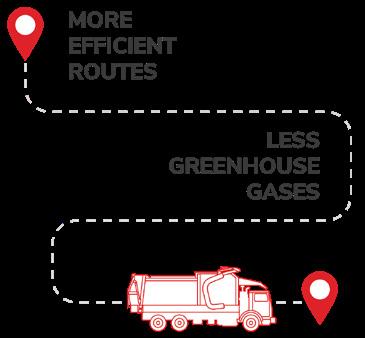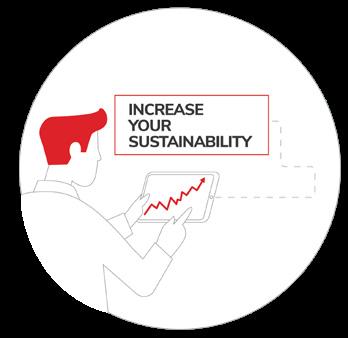
4 minute read
HOW WE WORK
Performance For The Planet
Performance for the planet — many promise it, WIN Waste practices it. We are proud to convert waste into renewable energy that goes back to the communities we serve. Through safe and responsible waste disposal and renewable energy production that powers homes and communities, WIN Waste strives to be an environmental leader that makes a difference in the lives of those around us.
WIN Waste is committed to the following core sustainability objectives related to environmental, social, and governance (ESG) principles:
• Provide a safe and secure workplace for employees.
• Minimize our operational impact on the environment.
• Reduce energy usage and the consumption of natural resources and other materials.
• Secure long-term value through comprehensive sustainability governance.
People
We cannot be the best in our business without a best-in-class team. WIN Waste recognizes that diverse perspectives make our company more innovative and resilient. That is why we are striving to be the most diverse, equitable, and inclusive workplace in our industry.
—
Major Account Manager WIN Waste DE&I Council member
CURB-TO-GRID APPROACH
Our waste management process begins and ends at the curbside. We collect our customers’ trash, process it and convert it into renewable energy at our facilities, then we return it back to the communities we serve in the form of electricity. Here’s how it works.
Step 1: Collect Waste
We use advanced analytics and logistics software to map our trash collection routes so they are as efficient as possible.

Step 2: Recover and recycle
We recover recyclable materials from the waste we collect so they can be made into new products, thus reducing the need for more extraction of limited natural resources.
Step 3: Convert
After recycling, we convert most of the remaining trash into renewable energy that we send onto the electric grid, powering homes across the Northeast and beyond.


Step 4: Measure
We measure every pound of trash collected and every megawatt of power generated — as well as many other sustainability indicators — and we share the data with customers so they can see their positive impact.

We manage customers’ waste in a safe and efficient manner that protects human health and the environment. Our services focus on recovering renewable attributes from the waste stream and sustainable end-of-life waste management, supporting the U.S. Environmental Protection Agency’s (EPA) sustainable material management strategy.
WIN WASTE’S NET CARBON REDUCTION
• Sustainable Waste Management
• Supporting the U.S. EPA’s Sustainable Materials Management Strategy
• Greenhouse Gas Emission Reduction
• Reducing emissions throughout the entire lifecycle of waste
• Resource Recovery
• Recovering commodities from the waste stream for reuse and recycling
Resource Recovery
• Renewable Energy Generation
• Recovering energy from waste at our renewables facilities and landfills
• Fossil Fuel Avoidance
• Reducing dependence on fossil fuels through recycling and energy recovery
• Sustainable Transportation
• Using the most fuel efficient and least carbon intensive modes of transportation
The most important waste management approach in our journey toward zero waste is source reduction and waste prevention. This means sourcing products that are manufactured and consumed in a way that prevents waste from being generated in the first place, and, once waste has been generated, recycling the maximum amount from the waste stream. At our facilities, WIN Waste recovers and recycles construction and demolition materials; comingled recyclables from municipal solid waste; and microscopic metals that we recover through advanced processing. The commodities and valuable natural resources we sort and recover from the waste streams we handle are sent to manufacturers who turn them into new products. This circular process reduces consumption of new raw materials.
ANNUAL AVERAGE
6.4M+ TONS OF WASTE CONVERTED INTO RENEWABLE ENERGY
340K+ HOMES POWERED WITH RENEWABLE ENERGY
Source: WIN Waste Innovations
4M+ TONS DELIVERED BY LOW-CARBON RAIL
354K+ TONS OF PAPER, PLASTIC AND METALS RECYCLED
133K+ TONS OF METAL RECOVERED
136K+ COLLECTIONS CUSTOMERS
Local Waste Management
The densely populated northeastern region of the United States generates more waste than it has the capacity to dispose of. This makes the Northeast states net exporters of waste. Each year, tractor trailers haul the states’ waste hundreds of miles to the nearest available disposal sites, taxing highway infrastructures and adding to traffic congestion, greenhouse gas emissions, and air pollution.
This crisis is expected to worsen as waste generation increases and landfills in the region reach capacity.
WIN Waste is proud to be part of the solution to this problem by offering local disposal and renewables facilities that are designed to divert waste from landfills. Collectively, WIN Waste Innovations prevents 6.4 million tons of waste from going to landfills each year.

Circular Economy
A circular economy employs industrial processes and economic activities that are restorative or regenerative by design and that enable resources used to maintain their highest value for as long as possible. In a circular economy, waste is dramatically reduced through the superior design of materials, products, and systems.
WIN Waste’s ability to optimize waste flows, maximize resource recovery, produce waste-derived renewable energy, and build decentralized, closed-loop customer partnerships are just some of the ways our company is helping drive the transition to a more circular global economy.
White Plains Linen
Steam is a natural byproduct of the waste conversion process at WIN Waste Innovations’ renewables facility in Westchester, New York.

In a unique partnership, WIN Waste gives this steam to nearby neighbor White Plains Linen Company, which is the largest commercial laundry operation in the United States. White Plains Linen uses the steam to power its operations. In doing so, the company reduces its use of natural gas, which prevents about 5,000 metric tons of greenhouse gas emissions annually.
The partnership offsets the equivalent of:
• 615,000 barrels of oil
• 43 million cubic feet of natural gas required to generate net megawatt hours










